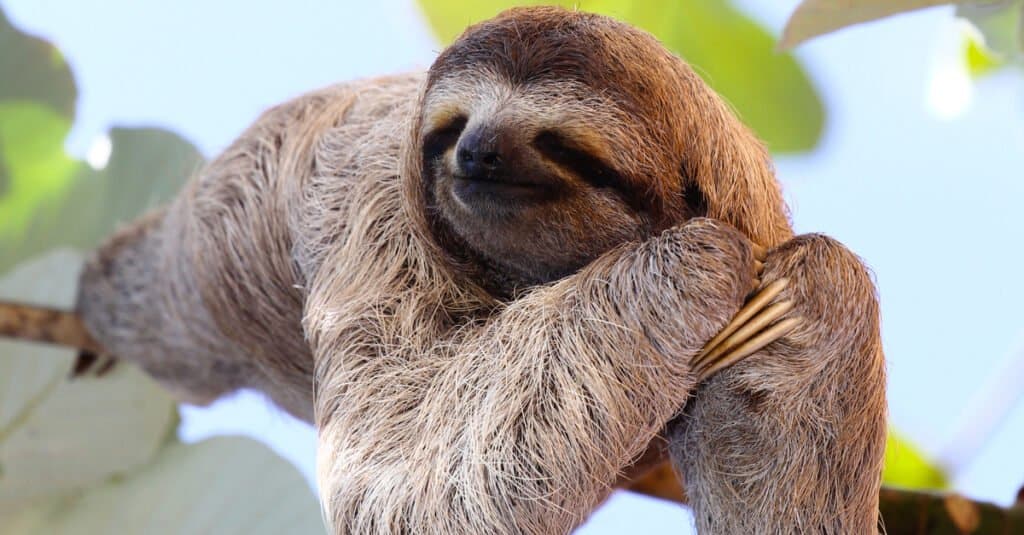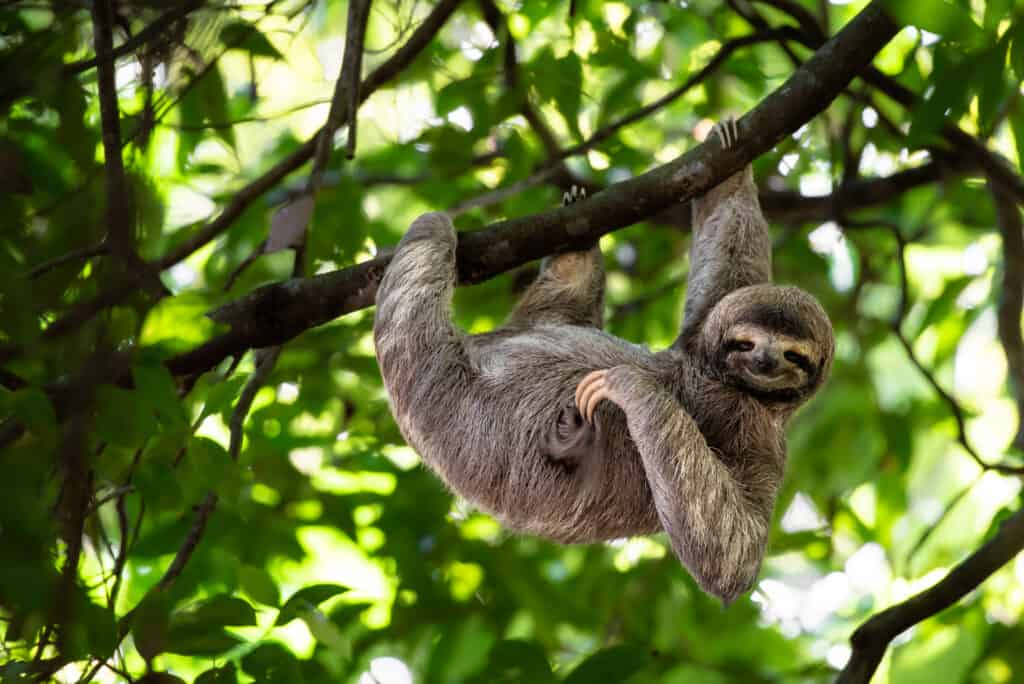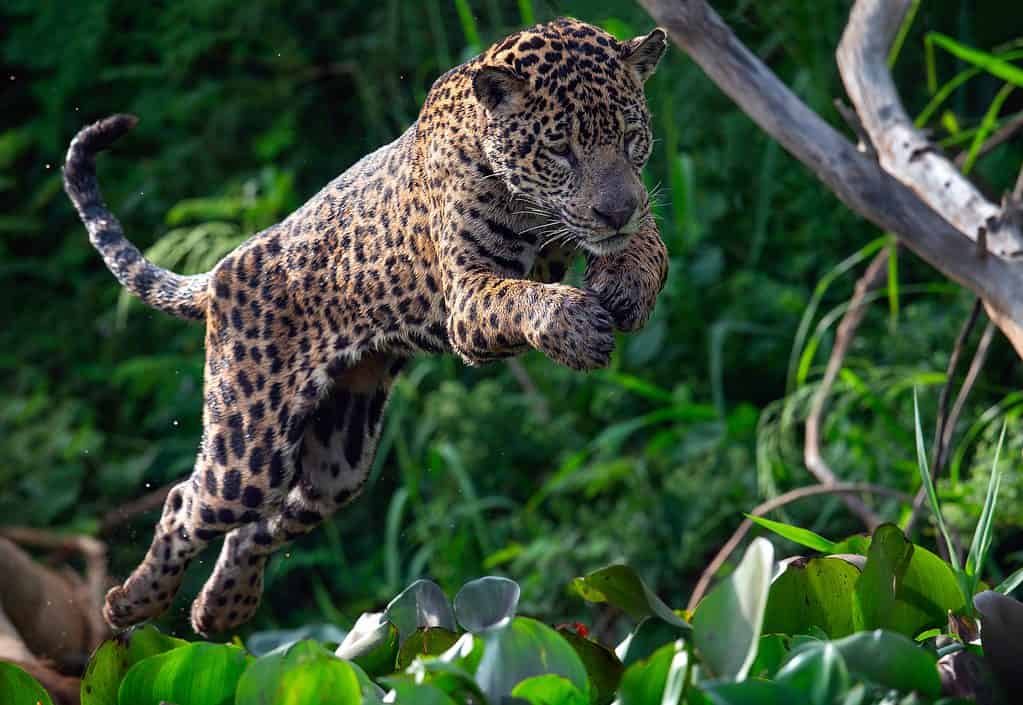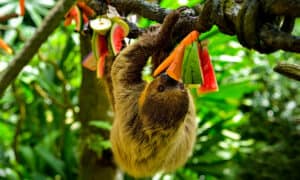Contrary to widespread assumption, sloths form groups in the wild, despite their slowness, laziness, and solitary nature.
A group of sloths is called a snuggle or bed of sloths mainly found on trees.
Numbers in a snuggle can range from ten sloths to as many as 40 in a single tree. However, many groups tend to maintain the minimum count.
Why Do Sloths Stick Together in Groups?
Sloths are not naturally gregarious creatures. However, there are a few situations in which they might band together. These include the following.
For Mating
Groups of sloths may gather around a female ready to mate. Male sloths usually gather around the female to compete for her attention, hoping to get chosen.
After Birth
Like all animals, newborn sloths need their mother to nurture and care for them before they grasp the world. For this reason, young sloths may remain close to their mother for a few months, creating a tiny family unit.

Sloths are not naturally gregarious creatures.
©Janossy Gergely/Shutterstock.com
What Is the Behaviour of Sloths While in Their Slumbers?
Sloths rarely engage in social interactions such as grooming or playing with one another when gathered in groups. Instead, they frequently cohabit harmoniously as each one goes about their daily activities.
Most of their time is spent sleeping or resting, with sporadic excursions outside the tree to urinate or eat leaves. It is not unexpected that sloths’ social behavior is not highly active, given that they are known to have a slow metabolism and spend most of their time resting.
How Do Sloths Live on Trees?
Despite their reputation for being slow-moving, sloths are well suited to live in the woods.
They Hang Upside Down
Sloths maintain an upside-down posture most of the time, thanks to their long, curled claws. While their metabolism is exceedingly slow, and they can go days without eating or moving, this posture also enables them to preserve energy.
Their Fur Has Teeny Grooves
Sloth’s fur is covered in teeny grooves, making the ideal home for symbiotic algae. In addition, the sloth sometimes licks the algae off its fur, which helps it blend in with the trees and gives extra nutrition.
They Have a Sectioned Stomach
Sloths have a unique stomach that is partitioned into different sections. This feature enables them to gradually digest the tough leaves and other types of vegetation that make up most of their diet.
They Stay in Groups
Sloths may utilize the concept of safety in numbers as a coping strategy when they are in a group. This improves their chances of spotting predators and protecting themselves by congregating. Moreover, grooming behavior, which can ease tension and create social relationships, is something that sloths may indulge in.
They Camouflage With the Environment
Because they often blend in with the surrounding trees and vegetation, sloths are so subtle that it can be challenging to identify them in a group. This makes it hard for any prey to detect their presence, making them safe.

Sloths maintain an upside-down posture most of the time, thanks to their long, curled claws.
©Lukas Kovarik/Shutterstock.com
How Do Sloths Interact With Each Other?
Despite their lack of activity, sloths do interact with one another. Sloths primarily use two techniques to communicate with each other. These include the following.
Vocalizations
The “scream,” a distinctive vocalization used only by sloths, is a high-pitched cry they may hear from afar. The scream is thought to warn other sloths of imminent danger or communicate for assistance.
Scent Marking
Another way that sloths interact with one another is by scent marking. On their necks, sloths employ scent glands to mark their territory.
They could also use their excrement and urine to mark their presence in a place. They use this technique to converse with other sloths, establish authority, and find mates.
What Preys on Sloths?
There are a few natural predators for sloths, including jaguars, harpy eagles, and humans, even though they are typically not aggressive creatures.
Sloths frequently attempt to blend in with their environment or flee to the shelter of the treetops to defend themselves. If necessary, they can swat at predators with their long claws.

Jaguars prey on sloths.
©Sergey Uryadnikov/Shutterstock.com
What Contribution Do Sloths Have to the World?
Although sloths may appear unproductive, lethargic creatures, they significantly impact their ecology and make numerous contributions to society. Here are some ways that sloths benefit the world:
Seed Dispersal
Sloths unintentionally scatter fruit seeds as they walk slowly through the trees, promoting the growth of new plant life. This is crucial in tropical rainforests, where there are lots of sloths.
Conservation
An important indicator species, sloths may reveal a lot about the state of their ecosystem by simply being present or absent.
Researchers can better understand how deforestation and other environmental changes affect the forest ecosystem by researching sloths and their behavior.
Ecotourism
In places like Costa Rica and Panama, where tourists can see sloths in their native habitat, sloths have become a well-liked ecotourism attraction. As a result, conservation activities are encouraged, and local economies are supported.
Medicinal Properties
Many bacteria that create bioactive substances with possible therapeutic benefits reside in the sloth’s fur. Investigations into the potential medical applications of these chemicals are currently being conducted.
The photo featured at the top of this post is © Damsea/Shutterstock.com
Thank you for reading! Have some feedback for us? Contact the AZ Animals editorial team.






